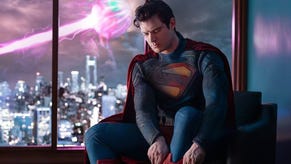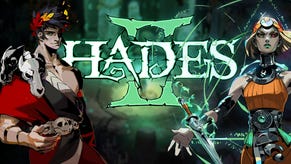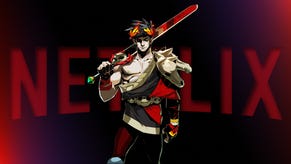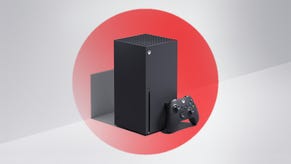DmC Devil May Cry: Right Game, Wrong Name?
2013 in Review: Mike takes a look at Capcom and Ninja Theory's reboot of the Devil May Cry series.
This article first appeared on USgamer, a partner publication of VG247. Some content, such as this article, has been migrated to VG247 for posterity after USgamer's closure - but it has not been edited or further vetted by the VG247 team.
Sometimes it's good to have a bit of distance to reflect on a game. As a consumer, when a game is launched, you tend to rely on the early impressions of others to get a feel of a game. Is it amazing? Does it live up to the series' name? Does it have a few missteps along the way? Unless our personal hype is huge, we tend to wait for the group concensus before diving in.
I just started reviewing games in July of this year. I've been in the games media for a few years now as a second job, but that was on the business side over at our sister site GamesIndustry International. So when Capcom and Ninja Theory's reboot of the Devil May Cry series came out in January, I skipped out. Devil May Cry fans weren't happy with the game and my backlog was already crazy, so I passed on the game until it was on sale. Having dived into the game since launch, I'd have to say I'm a bit surprised. It's pretty damn good.
DmC: Devil May Cry is an enjoyable game saddled with the Devil May Cry name and all the expectations that come with it.

Fight Me
Let's start with the combat, which is the primary difference between DmC and its predecessors. The two big changes here are the removal of style switching and the lock-on mechanic. Styles in Devil May Cry 3 and Devil May Cry 4 forced the player into certain playstyles, like the melee-focused Swordsmaster or the dodge-centric Trickster style. These were intended to push players in different directions, but at the highest-level, most veteran players tended to use the defense-focused Royalguard. When combined with animation cancelling on certain moves, timed parrying, and the Release attack, Dante could put out some crazy damage and became nearly invincible.

DmC drops Styles and instead gives players the ability to use any weapon or form at the press of a button. This gives neophyte and average players a bit more versatility and freedom compared to previous Devil May Cry games. DmC is more about letting you do what you want, when you want to.
The lock-on mechanic in older Devil May Cry games also directly informed the moves. Without the assumption that the player can be focused on a single enemy, the game is pushed away from the classic Devil May Cry titles and towards something closer to God of War. Basic moves have a wider area of attack, so you'll hit multiple enemies and evading (which is no longer tied to a specific style) becomes integral to gameplay.
What you're left with in DmC is a more straightforward and easier game for players. The gap between low- and high-level play is still considerable, but the barrier to entry is lower. Weapon switching on the fly makes it easier for players to hit S rank with their combos, compared to the difficulty of hitting S and above in older Devil May Cry games. To make combat slightly more difficult, Angel and Demon weapon requirements were added, indicated by simple color coding. The weapon switching system is wonderfully fluid, you just don't need to switch weapons that much outside of the previously-mentioned weapon requirements. Enemies even telegraph their moves in larger flourishes to give players ample time to evade.

For veteran Devil May Cry players, the game is painfully easy, a fact made worse by Dante's upgraded Demon Evade. With a well-timed, last-second Evade, Dante gains an increased damage bonus with makes most encounters much easier, mirroring the Release bonus from DMC 3 and 4's Royalguard.
This is DmC's strength and weakness. The new system is great at making players feel like they're in control of their own combos; many players will feel awesome when they're playing DmC, while Devil May Cry asked for more out of the player. More timing and precision was required to feel like you were truly powerful. The problem is veteran Devil May Cry players no longer had the outlet given to them by the previous games. What you're left with is a reboot that doesn't appeal to Devil May Cry fans, but is more open to new players. If you're not looking for the high-level of Devil May Cry, there's still a lot here to enjoy, but your expectations have to be different.
Tell Me A Story
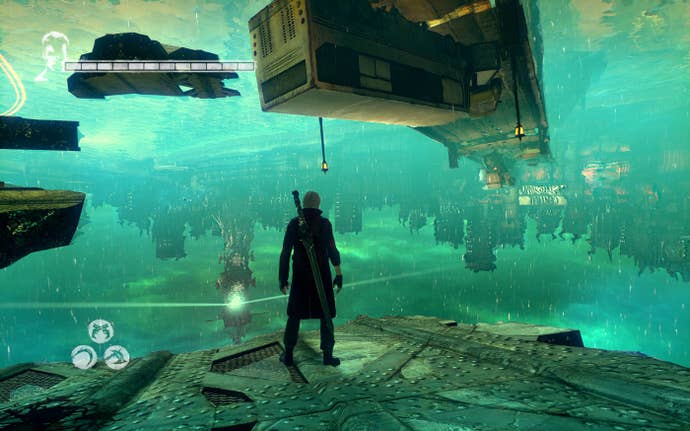
As with any reboot, Dante also has a new look and a new world to inhabit. Devil May Cry has never had the best story or dialog, and DmC does little to change that. The story here is more coherent than previous outings, but it doesn't particularly go anywhere and its themes are delivered in a heavy-handed way.
I'm largely fine with the new Dante. Ninja Theory steers him towards the crude side of "mature" at times and he's more serious than his predecessor, but there's a few nuggets of the original found inside of the new character. His path towards heroism follows the classic Hero's Journey and the other characters won't surprise you outside of one of them turning towards the dark side without any hints prior to the shift. This particular change just feels like checking off boxes related to the older games than blazing a new trail.
My small problem with DmC's story is a loss of tone. In previous Devil May Cry games, Dante was a outlandish character existing in a fantasy world that takes itself quite seriously. New Dante is closer to his world and I feel that something is a bit lost there. There was a lot of fun in the juxtaposition of serious fantasy tropes and melodrama alongside the crazy one-liners and cartoon-like tendencies of old Dante. Here's a Devil May Cry 3 cutscene to illustrate what I mean:
While Dante visited that that attempt at a serious tone sometimes in the older Devil May Cry games - he wasn't always exempt from the melodrama - the new Dante firmly lives in his gritty world, with small visits to the outlandish side at times. Another DmC could stick the landing, but the game missed my personal preference when it comes to the tone.
What a Wonderful World
If they missed the tone, one place where Ninja Theory got it absolutely right is visual design. DmC is a gorgeous game and absolutely outclasses the previous titles by a wide margin. I've been punctuating this article with some of the best high-res screenshots I could find to give you a taste of what's in the game.
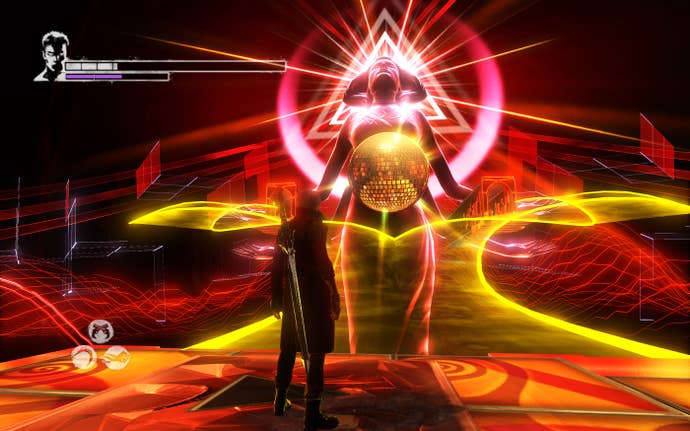
Levels tilt, shift, and change around Dante, taking him from the real world to Limbo. Even in the overall murky world of DmC, the colors in the levels are bright and stunning. Reds, greens, and blues are in full effect. I can safely say that DmC is probably the best-looking game I played this year. That's high praise for a studio whose previous games, Heavenly Sword and Enslaved, I didn't have a chance to play. Part of me wants Ninja Theory to get another chance at DmC just so I can see what they can do with the improved baseline on the Xbox One and PlayStation 4.
Note: All of these screenshots came from the same NeoGAF thread. It's literally the only thing that comes up when you look up large, high-res DmC images. Head there if you want to see the images in their original form; I had to shrink them to save you from downloading a ton of 2 MB images.
Stylish Finish
DmC: Devil May Cry was a game that was obviously made with a lot of love. DmC tells the story of Dante, son of Sparda and brother of Vergil. He wields the sword Rebellion and twin pistols named Ebony and Ivory. But that's where the similarities really end. The problem is if you wanted more Devil May Cry, this isn't that game. Its combat, tone, story, and art direction are completely different.
It's not the first game to get caught in that trap. Banjo and Kazooie: Nuts and Bolts is an underrated gem because players wanted more of the classic platforming gameplay, not the new build-a-vehicle system. Was it a bad game? No, just counter to expectations. There's the fine line between providing something different and really utilizing the franchise.



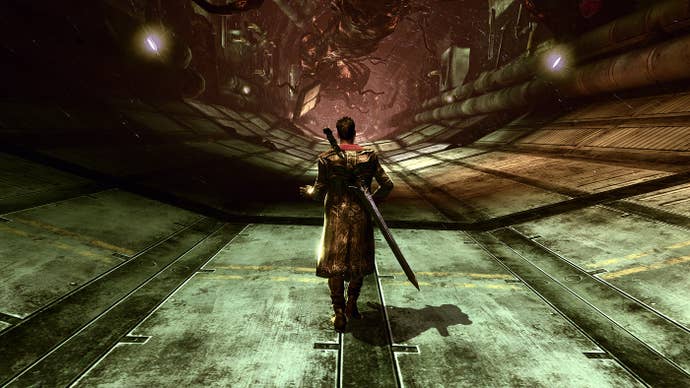
Will we get another DmC? Probably not. Sales didn't justify Capcom and Ninja Theory teaming up on the series again. DmC didn't reach Devil May Cry fans. It's also entirely possible that the Devil May Cry gameplay is inherently niche - Vanquish and Bayonetta didn't break records either - or a bigger IP is needed to boost sales, like Metal Gear Rising or Castlevania: Lords of Shadow.
But the differences in the reboot don't make DmC a bad game, they just make it a different game. I enjoyed every minute of my time in DmC. In fact, if you want to introduce someone to the Devil May Cry series, I'd say your best bet may be to start with DmC and then work your way back to the Devil May Cry HD Collection. Either way, if you can find it this holiday season for $20 - 30, DmC: Devil May Cry is a wild ride and one of my favorite games of 2013.
Note: If you're a technical player, pick up the PC version if you can. It plays at 60 fps, unlike its console counterparts.



